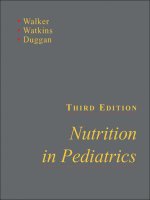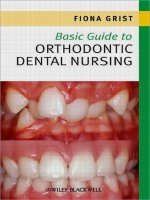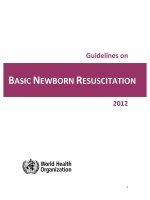Basic nurinsg arts
Bạn đang xem bản rút gọn của tài liệu. Xem và tải ngay bản đầy đủ của tài liệu tại đây (448.36 KB, 173 trang )
LECTURE NOTES
For Nursing Students
Basic Nursing Arts
Abraham Alano, B.Sc., M.P.H.
Hawassa University
In collaboration with the Ethiopia Public Health Training Initiative, The Carter Center,
the Ethiopia Ministry of Health, and the Ethiopia Ministry of Education
August 2006
Funded under USAID Cooperative Agreement No. 663-A-00-00-0358-00.
Produced in collaboration with the Ethiopia Public Health Training Initiative, The Carter
Center, the Ethiopia Ministry of Health, and the Ethiopia Ministry of Education.
Important Guidelines for Printing and Photocopying
Limited permission is granted free of charge to print or photocopy all pages of this
publication for educational, not-for-profit use by health care workers, students or
faculty. All copies must retain all author credits and copyright notices included in the
original document. Under no circumstances is it permissible to sell or distribute on a
commercial basis, or to claim authorship of, copies of material reproduced from this
publication.
©2006 by Abraham Alano
All rights reserved. Except as expressly provided above, no part of this publication may
be reproduced or transmitted in any form or by any means, electronic or mechanical,
including photocopying, recording, or by any information storage and retrieval system,
without written permission of the author or authors.
This material is intended for educational use only by practicing health care workers or
students and faculty in a health care field.
PREFACE
Nursing is core part in health service delivery system in which health
promotion,
disease
prevention,
curative
and
rehabilitative
health
strategies are applied. The skill of basic nursing art for the beginning
public heath nurse is of paramount important. The purpose of preparing
this lecture note is to equip public health nurses with basic nursing skills,
which will enable them to dispatch their responsibility as well as to
develop uniformity among Ethiopian Public Health Nurse Training Higher
Institutions.
The lecture note contains basic selected topics, which are relevant to their
scope. It is well known that no nursing service can be provided with out
basic skills of nursing art. For public health nurse to provide health service
at different settings; hospital, health center, health post and at the
community level, the course is very essential.
The lecture note is therefore organized in logical manner that students
can learn from simpler to the complex. It is divided in to units and sub
topics. Important abbreviations and glossaries have been included in
order to facilitate teaching learning processes. On top of that learning
objectives are clearly stated to indicate the required outcomes. Trial is
made to give some scientific explanation for procedure and some relevant
study questions are prepared to each unit to aid students understand the
subject.
ACKNOWLEDGMENTS
My deepest appreciation is to Carter Center and Professor Dennis
Carlson, senior consultant of the Center for his undivided and genuine
support starting from initiation of the lecture note preparation, provision of
materials and technical advise.
I also extend many thanks to colleagues from sisterly institutions and staff
of our department for their valuable comments and criticism, other wise
the lecture note would have not been shaped.
Similarly, my felt thanks is to supportive staff of Carter Center, Ato Aklilu
Mulugetta for his devoted support through the preparation of this lecture
note.
Last but not least, I thank all our College authorities for permission to work
on this lecture note besides the routine activities of the college.
ABBREVATIONS & SYMBOLS
A.C.
Before meal (ante cibum)
ACTH
Adreno cortico trophic hormone
AD.
As desired
AM.
Morning
AMALG
Amalgam filling
AMA
Against medical advice
A and P
Auscultation and percussion
APC
Aspirin, Phenacetine & caffeine
AQ
Aqueous
BID
Twice a day (bis in die)
B.M
Bowel movement
B.M.R.
Basal metabolic rate
B.P
Blood pressure
B.R.P.
Bathroom privilege
BUN
Blood urea nitrogen
o
Centigrade
C.B. C
Complete blood count
CC
Cubic centimeter
C.N. S.
Central nervous system
Co2
Carbon dioxide
C.S. F.
Cerebro- spinal fluid
D and C
Dilatation and Curettage
D/NS
Dextrose in normal saline
DPT
Diphtheria, pertusis, tetanus
D/W
Dextrose in water
Dx
Diagnosis
EEG
Electro encephalogram
E.E.N.T.
Eye, ear, nose, throat
C
ECG
Electrocardiogram
o
Fahrenheit
F.B.S.
Fasting blood sugar
F.H.B.
Fetal heartbeat
G.I.
Gastro intestinal
G or Gm
Gram
gr.
Grain
gt.
Drop (gutte)
gtt.
Drops
G.U.
Genito urinary
GYN.
Gynecology
HCL
Hydrochloric acid
Hb
Hemoglobin
HS
At bed- time (hours of sleep)
H2o
Water
I.V.
Intravenous
I.V.P
Intravenous pyelogram
KI.
Potassium iodide
L. P
Lumbar puncture
NaCl
Sodium Chloride
NOCTE
At night
N.P.O.
Nothing by mouth (nothing by os)
O.P.D.
Out Patient Department
O.R.
Operating room
PM
After noon
PRN
As needed, when necessary
Pt.
Patient
Q.
Every
Q.D.
Every Day
F
Q.H.
Every Hour
Q.I.D.
Four times a day
Q.N.
Every night
Q.O.D.
Every other day
R.B.C.
Red blood count or red blood cell
Rh.
Rhesus factor
Rx
Prescription, take
Sol.
Solution
SOS
If necessary
STAT
Immediately -at once
S.C
Subcutaneous
T. I.D
Three times a day
T.P.R.
Temperature, pulse, respiration
Tsp
Teaspoon, tablespoon
U.R.
Upper right
WBC
White blood cells
Wt.
Weight
U.R.Q.
Upper right quadrant
U.L.Q.
Upper lower quadrant
UTI
Urinary tract Infection
1
Basic Nursing Art
Contents
Preface
i
Acknowledgement
ii
Abbreviation
iii
Unit One
Introductiion
1
Unit Two
Care of the patient unit and equipment
4
Unit Three
Bed Making
22
Unit Four
General care of the patient
29
Unit Five
Observation and laboratory diagnosis
57
Unit Six
Cold and heat application
89
Unit Seven
Elimination of Gastro Intestinal And Urinary Tract
92
Unit Eight
Medication Administration
111
Unit Nine
Wound care
138
Unit Ten
Pre & postoperative nursing care
151
Unit Eleven
Post- mortem care
162
Glossary
165
References
169
1
Basic Nursing Art
UNIT ONE
INTRODUCTION
Nursing
Definition:
It is assisting the individual, sick or well in the performance of those
activities contributing to health or its recovery (to peaceful death) that he
will perform unaided, if he had the necessary strength, will or knowledge
and to do this in such a way as to help him gain independence as rapidly
as possible (Virginia Henderson 1960).
Nursing is the art and science involves working with individual, families,
and communities to promote wellness of body, mind, and spirit. It is a
dynamic, therapeutic and educational process that serves to meet the
health needs of the society, including its most vulnerable members.
Historical Background of Nursing
In the early ages, much of the practice of medicine was integrated with
religious practices. Before the development of modern nursing, women
of nomadic tribes performed nursing duties, such as helping the very
young, the old, and the sick, care-dwelling mothers practiced the nursing
of their time.
As human needs expanded, nursing development broadened; its interest
and functions through the social climates created by religious ideologies,
economics, industrial revolutions, wars, crusades, and education. In this
way modern nursing was born.
The intellectual revolution of the 18th and 19th centuries led to a scientific
revolution. The dynamic change in economic and political situations also
influenced every corner of human development including nursing. It was
during the time of Florence Nightingale that modern nursing developed.
Basic Nursing Art
2
She greatly modified the tradition of nursing that existed
before her era. She also contributed to the definition of nursing " to put
the patient in best possible way for nature to act." Since her time modern
nursing development has rapidly occurred in many parts of the world.
History of Nursing in Ethiopia
Even though Ethiopia is one of the oldest countries in the world,
introduction of modern medicine was very late. Health care of
communities and families was by Hakim (wogesha or traditional healers).
Around 1866 missionaries came to Eritrea, (one of the former provinces
of Ethiopia) and started to provide medical care for very few members of
the society. In 1908 Minlik II hospital was established in the capital of
Ethiopia. The hospital was equipped and staffed by Russians.
Later hospital building was continued which raised the need to train
health auxiliaries and nurses. In 1949 the Ethiopian Red Cross, School of
Nursing was established at Hailesellasie I hospital in Addis Ababa. The
training was given for three years. In 1954 HailesellasieI Public Health
College was established in Gondar to train health officer, community
health nurses and sanitarians.
During the regimen of 'Dergue', the former bedside and community health
nursing training was changed to comprehensive nursing. An additional
higher health professional training institution was also established in 1983
In Jimma.
After the overthrown of the Dergue, the transitional government of
Ethiopia developed a health policy that emphasizes health promotion,
diseases prevention, and curative and rehabilitative health service with
priority to the rural societies. As the result of the policy the training of
public health nursing at the diploma level came in to existence since
1995. Additional public health higher training institutions were established
at Dilla and Alemaya in 1996. The outputs of these training institutions
are providing services all over the country.
3
Basic Nursing Art
UNIT TWO
CARE OF THE PATIENT UNIT AND EQUIPMENT
Learning Objective
At completion of this unit the learner will be able to:
•
State the general instruction for nursing procedures.
•
Define patient and patient unit.
•
Take care of patient unit and equipment in health care facilities
•
Admit and discharge patients according to agency policy
•
Assist helpless patients to move and maintain normal body
alignment
General Instructions for All Nursing Procedures
1.
Wash your hands before and after any procedure.
2.
Explain procedure to patient before you start.
3.
Close doors and windows before you start some procedures like
bed bath and back care.
4.
Do not expose the patient unnecessarily.
5.
When ever possible give privacy to all patients according to the
procedure.
6.
Assemble necessary equipment before starting the procedure.
7.
After completion of a procedure, observe the patient reaction to the
procedure, take care of all used equipment and return to their
proper place.
8.
Record the procedure at the end.
4
Basic Nursing Art
A.
Care of Patient Unit
I.
THE PATIENT UNIT
Definition:
Patient:
A Latin word meaning to suffer or to bear.
Is a person who is waiting for or undergoing medical
-
treatment and care.
A.
Patient
Care
Unit:
is
the
space
where
the
patient
is
accommodated in hospital and consists of the bed, an over bed
table, a bedside table, and possibly a chair. There may also be
closet space or drawer.
The patient unit is of three types:
1.
Private room – is a room in which only one patient be
admitted
2.
Semi private room – is a patient unit which can
accommodate two patients
3.
Ward- is a room, which can receive three or more patients.
Consists of a hospital bed, bed side stand, over bed table,
chair, overhead light, suction and oxygen, electrical outlets,
sphygmomanometer, a nurses call light, waste container and
bed side table.
B.
Hospital Bed
•
Gatch bed: a manual bed which requires the use of hand
racks or foot pedals to manipulate the bed into desired
positions i.e. to elevate the head or the foot of the bed
⇒
Most commonly found in Ethiopia hospitals
⇒
Are less expensive and free of safety hazard
⇒
Handles should be positioned under the bed when not in
use
5
Basic Nursing Art
C.
Side rails
•
Half rails – run only half the length of the bed, are meant to
prevent client falls
•
It should be attached to both sides of the bed
♦
Rails
– Full rails – run the length of the bed
– Half rails _ run only half the length of the bed and
commonly attached to the pediatrics bed.
D.
Bed Side Stand
•
Is a small cabinet that generally consists of a drawer and a
cupboard area with shelves
•
Used to store the utensils needed for clients care. Includes
the washbasin (bath basin, emesis (kidney) basin, bed pan
and urinal
•
Has a towel rack on either sides or along the back
•
Is best for storing personal items that are desired near by or
that will be used frequently
E.g. soap, shampoo, lotion etc
E.
Over Bed Table
•
The height is adjustable
•
Can be positioned and consists of a rectangular, flat surface
supported by a side bar attached to a wide base on wheels
•
Along side or over the bed or over a chair
•
Used for holding the tray during meals, or care items when
completing personal hygiene
F.
The Chair
•
Most basic care units have at least one chair located near
the bedside
6
Basic Nursing Art
•
For the use of the client, a visitor, or a care provider
G. Overhead Light (examination light)
•
Is usually placed at the head of the bed, attached to either
the wall or the ceiling
H.
•
A movable lamp may also be used
•
Useful for the client for reading or doing close work
•
Important for the nurse during assessment
Suction and Oxygen Outlets
•
Suction is a vacuum created in a tube that is used to pull
(evacuate) fluids from the body E.g. to clear respiratory
mucus or fluids
•
Oxygen is one of the gases frequently used for health care
today. Oxygen is derived through a tube.
I.
Electrical Outlets
•
J.
Almost always available in the was at the head of the bed
Sphygmomanometer
•
The blood pressure assessment tool, has two types:
1. An aneroid
2. Mercury, which is frequently used during nursing
assessment.
K.
Call Light
•
Used for client’s to maintain constant contact with care
providers
II.
Care of Patient Unit
•
Nursing staffs are not responsible for actual cleaning of dust
and other dirty materials from hospital. However, it is the
7
Basic Nursing Art
staff nurses' duty to supervise the cleaner who perform this
job.
A. General Rules for Cleaning
•
Dry dusting of the room is not advisable.
•
Dusting should be done by sweeping only
•
Use a damp duster for collecting dust
•
Dust with clear duster
•
Collect dust at one place to avoid flying from place to place
•
Dusting should be done without disturbing or removing the patients
from bed
•
Dusting should be done from top to bottom i.e. from upward to
downward direction
•
While dusting, take care not to spoil the beds or walls or other
fixtures in the room or hospital ward
•
While dusting, wounds or dressing should not be opened by other
staff
•
There should be a different time for dusting daily
B.
Care of Hospital and Health Care Unite Equipments
1.
General Instructions for Care of Hospital Equipment
•
Use articles only for the purpose for which they are intended
•
Keep articles clean and in good condition. Use the proper
cleaning method
•
Protect mattresses with rubber sheets
•
Use protective pillowcases on pillows.
•
Do
not
boil
articles,
especially
rubber
articles
and
instruments longer than the correct time
•
Do not sterilize rubber goods and glass articles together wrap glass in gauze when sterilizing it by boiling
8
Basic Nursing Art
•
Protect table tops when using hot utensils or any solution
that may leave stain or destroy the table top
•
2.
Report promptly any damaged or missing equipment
Care of Equipment in General
•
Rinse used equipment in cold water. Remove any sticky
material.
Hot water coagulates the protein of organic
material and tends to make it adhere
•
Wash well in hot soapy water. Use an abrasive, such as a
stiff-bristled brush, to clean equipment
3.
•
Rinse well under running water
•
Dry the article
•
Clean the gloves, brush and sink
Care of Linen and Removal of Stains
•
Clean linen should be folded properly and be kept neatly in
the linen cupboard
•
Dirty linen should be put in the dirty linen bag (hamper) and
never be placed on the floor
•
Torn linen should be mended or sent to the sewing room
•
Linen with blood should be soaked in cold water to which a
small amount of hydrogen peroxide is added if available
•
Linen stained with urine and feces is first rinsed in cold water
and then washed with soap
•
Iodine stained linen- apply ammonia, rinse and then wash
with cold water
•
Ink stained linen – first soak in cold water or milk for at least
for 24 hrs then rub a paste of salt and lemon juice on the
stain and allow the article to lie in the sun
•
Tea or coffee stains – wash in cold water and then pour
boiling water on the stain
9
Basic Nursing Art
•
To remove vitamin B complex stains dissolve in water or
sprit
4.
•
Mucus stains – soak in salty water
•
Rust _ soak in salt and lemon juice and then bleach in sun
Care of Pick Up Forceps and Jars
Pick up forceps:
an instrument that allows one to pick up
sterile equipment.
Sterile equipment:
material, which is free of all forms of
microorganism.
Pick up forceps should be kept inside the jar in which 2/3 of the jar
should be filled with antiseptic solution
•
Wash pick up forceps and jars and sterilize daily
•
Fill jar with disinfectant solution daily
•
Care should be taken not to contaminate tip of the forceps
•
Always hold tip downward
•
If tip of forceps is contaminated accidentally, it should be
sterilized before placing it back in the jar to avoid
contamination.
5.
Rubber Bags
Example: hot water bottles, ice bags should be drained and dried
They should be inflated with air and closed to prevent the sides
from sticking together
6.
Rubber Tubing
•
Should be washed with warm, soapy water
•
The inside should be flushed and rinsed well
Admission and Discharge
A.
Admission
10
Basic Nursing Art
Admission is a process of receiving a new patient to an individual unit
(ward) of the hospital. (Hospitalized individuals have many needs and
concerns that must be identified then prioritized and for which action must
be taken).
Purpose
•
To help a new patient to adjust to hospital
•
To alleviate the patient's fear and worry about the hospitalization.
Nurse's Responsibilities During Admission of a Patient to Hospital
1.
Check for orders of admission
2.
Assess the patient's immediate need and take action to meet them.
These needs can be physical (e.g. acute pain) or emotional
distress, (upset)
3.
Make introduction and orient the patient
•
Greet the patient
•
Introduce self to the patient and the family
•
Explain what will occur during the admission process
(admission routines) such as admission bath, put on hospital
gowns etc.
•
Orient patient to individual unit: Bed, bathroom, call light,
supplies and belonging; and how these items work for
patient use.
•
Orient patient to the entire unit: location of nurses office,
lounge etc.
•
Explain anything you expect a patient to do in detail. (this
helps the patients participate in their care).
•
4.
Introduce other staff and roommates.
Perform base line assessment
a.
Observation and physical examination such as:
•
Vital signs; temperature pulse, respiration and blood
pressure
11
Basic Nursing Art
b.
•
Intake and output
•
Height and weight (if required)
•
General assessment
Interview patient and take nursing history to determine what
medication the patient is currently taking, any allergies, and
patient's entering complaints and concern.
5.
Take care of the patient's personal property
•
Items that are not needed can be sent home with family
members
•
Other important items can be kept at bedside or should be
put in safe place by cabling with patient's name.
6.
B.
Record keeping or maintaining records
•
Record all parts of the admission process
•
Other recording include
⇐
Notification to dietary departments
⇐
Starting kardex card and medication records
⇐
If there is specific form to the facility, complete it.
Discharging a Patient
Indications for discharge
•
Progress in the patient's condition
•
No change in the patient's condition (Referral)
•
Against medical advice
•
Death
Nurse's Responsibility During Discharging a Patient
1.
Check for orders that a patient need to be discharged
2.
Plan for continuing care of the patient
•
Referral as necessary
Basic Nursing Art
•
12
Give information for a new person involved in the patient
care.
3.
4.
•
Contact family or significant others, if needed.
•
Arranging transportation
Teaching the patient about
•
What to expect
•
Medications (Treatments)
•
Activity
•
Diet
•
Need for continued health supervision
Do final assessment of physical and emotional status of the
patient and the ability to continue own care.
5.
Check and return all patients’ personal property (bath items in
patient unit and those kept in safe area).
6.
Help the patient or family to deal with business office for customary
financial matters and in obtaining supplies.
7.
Keep records
o
Write discharge note
o
Keep special forms for facility
Discharge summaries usually include:
•
Description of client’s condition at discharge
•
Current medication
•
Treatment (e.g. Wound, care, O2 therapy)
•
Diet
•
Activity level
•
Restrictions
Reason for referral include the following:
•
Any active health problems
Basic Nursing Art
•
Current medication
•
Current treatments that are to be continued
•
Eating and sleeping habits
•
Self-care abilities
•
Support networks
•
Life-style patterns
•
Religious preferences
13
Discharging a patient against medical advice (AMA)
1.
When the patient want to leave an agency without the permission
of the physician - unauthorized discharge the following activities
are indicated:
2.
Ascertain why the person wants to leave the agency
3.
Notify the physician of the client’s decision
4.
Offer the patient the appropriate form to complete
5.
If the client refuses to sign the form, document the fact on the form
and have another health professional witness this
6.
Provide the patient with the original of the signed form and place a
copy in the record
7.
When the patient leaves the agency, notify the physician, nurse in
charge, and agency administration as appropriate
•
Assist the patient to leave as if this were a usual discharge
from the agency (the agency is still responsible while the
patient is on premises)
Charting
Chart:
is a written record of history, examinations, tests, diagnosis,
prognosis, therapy and response to therapy
Purpose
Basic Nursing Art
•
14
To document diagnosis or treatment of a patient while in the
hospital and after discharge if the patient return for treatment at a
future time.
•
To maintaining accurate date on matters demand by courts
•
To providing material for research
•
To serve as information in the education of health personnel
•
To secure needed vital statistics
•
To promoting public health
General Rules for Observation and Recording
♦
Spelling
♦
Accuracy
♦
Completeness
♦
Exactness
♦
Legibility
♦
Neatness
♦
Errors
♦
Composition
♦
Sentences
Definition of Signs and Symptoms
Objective information (sign):
The health personnel and the patient readily observe those signs such
as;
swelling, redness rash, body discharge, vital signs, laboratory results
Subjective information (symptom)
•
Felt by the patient only
•
Experienced by the patient them selves and made known to the
health personnel only through complaints of patient. E.g. Nausea,
headache, numbness
15
Basic Nursing Art
As part of the admission process a new chart should be
opened and certain forms must be filled
Orders of Assembling Patients Chart
a.
Order sheet
b.
Progress notes (may differ from hospital to hospital)
c.
Nursing notes
d.
Vital sign sheet
e.
Laboratory reports
Safety and Comfort Measures and Devices
1.
Cotton Rings: are small circles of cotton rolled with gauze or
bandage with hole in the middle.
Used to relieve pressure from small areas such as the elbows and
hells
2.
Air Rings:
•
Should be filled with air and covered with pillow case
•
Not commonly used
•
Should be changed frequently
•
Used to relieve pressure from the buttocks (to prevent bed
sore)
3.
Cradles (Bed Cradle):
•
Also called Anderson frame.
•
Is a frame, which is made of wire, wood or iron.
•
Designed to keep the top bedclothes off the feet, legs, and
even abdomen of client in case of injury.
4.
Pillow:
•
Placed under head, back, between knees or at the foot of
the bed to prevent
foot drop and keep the patient.
Basic Nursing Art
•
16
Are used to give comfort, support and to position a patient
properly.
5.
Sand Bags:
•
Are heavy, cylindrical or rectangular sand-filled bags.
•
Are used for supporting or immobilizing a limb.
•
They should be covered with towel and placed one on either
side of a limb (or part to be immobilized).
6.
Splints:
Are rigid supports that help maintain the wrists in hyperextension as
a means of
Preventing palmar flexion and constructors.
7.
8.
Fracture boards:
•
Used to make the bed firm and to prevent bed from sagging.
•
They are placed under the mattress of patients with fracture.
Backrest:
Used for elevating and supporting the head and back of the
patient.
•
Gatch beds have back rest which can be elevated or lowered
as desired
•
9.
Pillows or boards can be used if gatch bed is not available
Foot rest (board):
•
Are rigid, vertical structures.
•
Are placed at the foot of the bed.
•
Help to maintain the ankles in their normal functional position
in order to prevent foot drop and also prevent the patient
from sliding down.
•
Should be padded for support.
17
Basic Nursing Art
•
Should be adjusted to the client's height so that the soles rest
firmly against it and the ankles are maintained at 900.
Lifting and Moving a Patient
Body Mechanics: is the effort; coordinated, and safe use of the body to
produce
•
motion and maintain balance during activity
A person maintains balance as long as the line of gravity
passes through the center of the body and the base support
Line of gravity: an imaginary vertical line drawn through an object’s
center of gravity
•
The point at which all of the mass of an object is centered
•
Base of support: the foundation on which an object rests
Principles
•
Balance is maintained and muscle strain is avoided as long as the
line of gravity passes through the base of support
•
The wider the base of support and the lower the center of gravity,
the greater the stability
•
Objects that are close to the center of gravity are moved with the
least effort
Purpose of Proper Body Mechanics
•
Promotes body musculoskeletal functioning
•
Reduces the energy required to move and maintain balance
•
Reduce fatigue and decreases the risk of injury
•
Facilitates safe and efficient use of appropriate groups of muscles
The center of gravity of a well-aligned standing adult is located slightly
anterior to the upper part of the sacrum.
Standing position posture:
is unstable because of a narrow base of
support, a high center of gravity and a constantly shifting line of gravity.









